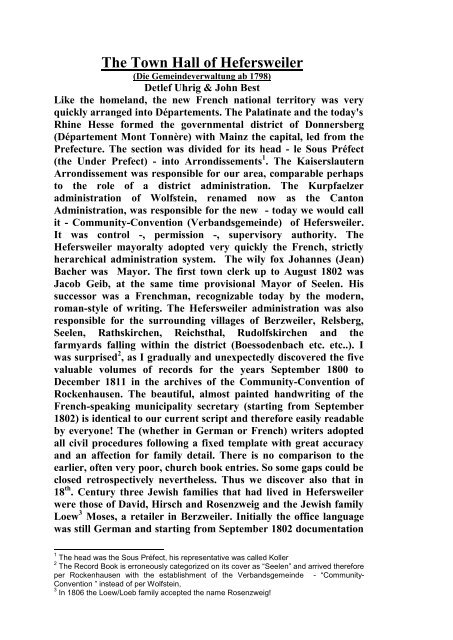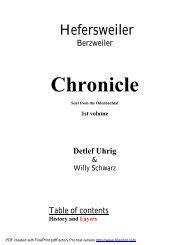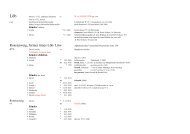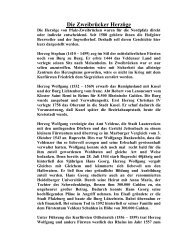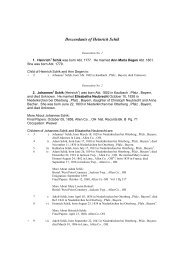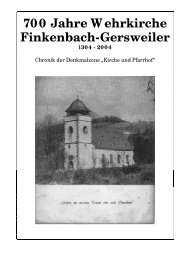The Town Hall of Hefersweiler
The Town Hall of Hefersweiler
The Town Hall of Hefersweiler
Create successful ePaper yourself
Turn your PDF publications into a flip-book with our unique Google optimized e-Paper software.
<strong>The</strong> <strong>Town</strong> <strong>Hall</strong> <strong>of</strong> <strong>Hefersweiler</strong><br />
(Die Gemeindeverwaltung ab 1798)<br />
Detlef Uhrig & John Best<br />
Like the homeland, the new French national territory was very<br />
quickly arranged into Départements. <strong>The</strong> Palatinate and the today's<br />
Rhine Hesse formed the governmental district <strong>of</strong> Donnersberg<br />
(Département Mont Tonnère) with Mainz the capital, led from the<br />
Prefecture. <strong>The</strong> section was divided for its head - le Sous Préfect<br />
(the Under Prefect) - into Arrondissements 1 . <strong>The</strong> Kaiserslautern<br />
Arrondissement was responsible for our area, comparable perhaps<br />
to the role <strong>of</strong> a district administration. <strong>The</strong> Kurpfaelzer<br />
administration <strong>of</strong> Wolfstein, renamed now as the Canton<br />
Administration, was responsible for the new - today we would call<br />
it - Community-Convention (Verbandsgemeinde) <strong>of</strong> <strong>Hefersweiler</strong>.<br />
It was control -, permission -, supervisory authority. <strong>The</strong><br />
<strong>Hefersweiler</strong> mayoralty adopted very quickly the French, strictly<br />
herarchical administration system. <strong>The</strong> wily fox Johannes (Jean)<br />
Bacher was Mayor. <strong>The</strong> first town clerk up to August 1802 was<br />
Jacob Geib, at the same time provisional Mayor <strong>of</strong> Seelen. His<br />
successor was a Frenchman, recognizable today by the modern,<br />
roman-style <strong>of</strong> writing. <strong>The</strong> <strong>Hefersweiler</strong> administration was also<br />
responsible for the surrounding villages <strong>of</strong> Berzweiler, Relsberg,<br />
Seelen, Rathskirchen, Reichsthal, Rudolfskirchen and the<br />
farmyards falling within the district (Boessodenbach etc. etc..). I<br />
was surprised 2 , as I gradually and unexpectedly discovered the five<br />
valuable volumes <strong>of</strong> records for the years September 1800 to<br />
December 1811 in the archives <strong>of</strong> the Community-Convention <strong>of</strong><br />
Rockenhausen. <strong>The</strong> beautiful, almost painted handwriting <strong>of</strong> the<br />
French-speaking municipality secretary (starting from September<br />
1802) is identical to our current script and therefore easily readable<br />
by everyone! <strong>The</strong> (whether in German or French) writers adopted<br />
all civil procedures following a fixed template with great accuracy<br />
and an affection for family detail. <strong>The</strong>re is no comparison to the<br />
earlier, <strong>of</strong>ten very poor, church book entries. So some gaps could be<br />
closed retrospectively nevertheless. Thus we discover also that in<br />
18 th . Century three Jewish families that had lived in <strong>Hefersweiler</strong><br />
were those <strong>of</strong> David, Hirsch and Rosenzweig and the Jewish family<br />
Loew 3 Moses, a retailer in Berzweiler. Initially the <strong>of</strong>fice language<br />
was still German and starting from September 1802 documentation<br />
1 <strong>The</strong> head was the Sous Préfect, his representative was called Koller<br />
2 <strong>The</strong> Record Book is erroneously categorized on its cover as “Seelen” and arrived therefore<br />
per Rockenhausen with the establishment <strong>of</strong> the Verbandsgemeinde - “Community-<br />
Convention ” instead <strong>of</strong> per Wolfstein,<br />
3 In 1806 the Loew/Loeb family accepted the name Rosenzweig!
was conducted in French only. Mayor Johannes/Jean Bacher was at<br />
the same time also Registrar <strong>of</strong> Births, Marriages and Deaths and<br />
therefore signed with “faisant les fonctions more d'<strong>of</strong>ficier public de<br />
l'état civil”.<br />
Since the Jewish families in Europe obviously had no fixed<br />
surnames and children were named alternately after the father and<br />
then after the mother, the national administrations was <strong>of</strong>ten times<br />
confused. <strong>The</strong> French ministry <strong>of</strong> the Interior issued therefore on<br />
July 20 th , 1806 an Imperial Decree with reference to the Jews who<br />
did not have certain family and first names. <strong>The</strong> citizens <strong>of</strong> our<br />
realm who pr<strong>of</strong>ess themselves to be <strong>of</strong> the Hebrew culture must<br />
accept a surname within three months, - the Biblical first name was<br />
not to be reused as a surname but another city name may be used.<br />
<strong>The</strong> Loebs (Loew) took the name >Rosenzweig< (branch <strong>of</strong> a rose)<br />
and the former Isaak family took the name >Felsenthal< (valley <strong>of</strong><br />
the rocks).<br />
<strong>The</strong> municipal <strong>of</strong>fice (mayoralty and school) <strong>of</strong> <strong>Hefersweiler</strong> was<br />
accommodated in the old building <strong>of</strong> 1696 4 , in which the maître<br />
d'école (schoolmaster) Mohr 5 also taught and lived and starting<br />
from 1803/4 the schoolmaster Heinrich Steinebrey 6 . For the<br />
population a French first name could require some getting used to.<br />
But in any case it was easier stamping SAM, than our Germans<br />
Johannes changed to Jean, Ludwig became Louis, Elisabetha was<br />
now called Lisette. This custom may have continued in existence up<br />
to the Secessionist Period <strong>of</strong> 1922/23.<br />
This introduction <strong>of</strong> the modern, National Register Office resulted<br />
in correct and comprehensive entries, a condition <strong>of</strong> every<br />
efficiently-working administration. Now there were no more<br />
coincidental entries, dependent on the wishes and moods <strong>of</strong> the<br />
respective religious gentlemen! Thank God religion no longer<br />
played a role. Now everyone’s details were captured, no matter<br />
whether they were Catholic, Jewish or Reform. Also the language<br />
became like light verse. No more bad words about illegitimate<br />
children and their mothers. If a wife (e.g. Madame Barbe <strong>The</strong>iss)<br />
bore her second illegitimate child, then the writer noted this without<br />
4 Nevertheless you should visit sometime the old <strong>Hefersweiler</strong> bell <strong>of</strong> 1696, which is located<br />
now in the school hall <strong>of</strong> Berzweiler, first OG!<br />
5 See Family Chronicle, volume 2<br />
6 Heinrich Steinebrey, Born 1 st . May1763 in Relsberg, was - starting in 1804 and up to his<br />
death in 13 March 1835 - a teacher in <strong>Hefersweiler</strong>. He was thus still instructing as 72-year<br />
old. His successor was a teacher from Essweiler – „Barthelmae“
comment. Also the introduction <strong>of</strong> civil marriage began<br />
progressively from September 1798. Weddings were on Sundays,<br />
probably starting from 11 o'clock. At noon, the Mayor Bacher<br />
announced, with a loud voice, the completed marriage ceremony to<br />
the citizenry assembled at the outer door <strong>of</strong> the community center.<br />
Initially the pair who were present before the Registrar <strong>of</strong> Births,<br />
Marriages and Deaths had to have two - then starting from 1802 -<br />
four witnesses to their consent to marriage. In the German Reich,<br />
this progressive law was not used until1876!<br />
Johann Friedrich Daberkow 7 probably came to <strong>Hefersweiler</strong> in<br />
1809. He was single and fell in love with pretty Maria Elisabetha<br />
Bayer. Christmas 1809 was probably the engagement and the bride<br />
and groom visited Jean Bacher, the mayor. He explained the<br />
difficulties to him, particularly since Daberkow originated from the<br />
far-<strong>of</strong>f Kingdom <strong>of</strong> Prussia. Jean Bacher immediately wrote to the<br />
local administration <strong>of</strong> his place <strong>of</strong> residence (Massow in<br />
Pommern). <strong>The</strong> required excerpt from the Birth Register, which<br />
had been issued on 20 May 1810 by the Municipality <strong>of</strong> Massow 8 ,<br />
arrived nearly 10 months later. Mayor Bacher’s report was<br />
celebrated, and he then let the Mayor <strong>of</strong> Niederkirchen examine the<br />
birth entry for Maria Elisabetha Bayer – the birth had taken place<br />
on 3 October 1810 9 . Finally, on 20 th and 27 th <strong>of</strong> January the notice<br />
<strong>of</strong> an intended marriage were hung up on the outer door 10 and the<br />
marriage ceremony took place on February 5 th , 1811. By the way<br />
at that time the beautiful custom arose <strong>of</strong> decorating the <strong>of</strong>ficial<br />
announcement box with seasonal flowers. <strong>The</strong> mother Charlotta<br />
Bayer gave her agreement to the wedding to the notary <strong>of</strong> Wolfstein<br />
Charles Jaques Schuler, because she would certainly have been<br />
7) Johann Friedrich Daberkow was born 2 October 1782 in Massow / Pommern, his<br />
parents were Christoph Daberkow and Dorothea Schmid. By occupation he was butcher, in<br />
other documents he was also designated as “Bader”. According to wedding document N° 3<br />
from 1811 he lived legally in <strong>Hefersweiler</strong>, married Maria Elisabetha Bayer (born 17<br />
March 1789, died 20 June 1861 in Niki) daughter <strong>of</strong> Charlotta Bayer and Johann Peter<br />
Steinhauer on 5 February 1811 in the community centre in <strong>Hefersweiler</strong>.<br />
8) As at March 1813 <strong>The</strong> Kingdom <strong>of</strong> Prussia still belonged to friendly, but dependent<br />
states <strong>of</strong> France. Only in 1813 did Prussia separate itself from Napoleonic clutches and<br />
followed Russia!<br />
9) <strong>The</strong> Lutheran-Evangelist Church book lay in the Mayor’s Office <strong>of</strong> Niederkirchen. As for<br />
<strong>Hefersweiler</strong> above, representation <strong>of</strong> Berzweiler and Relsberg belonged to the Niki<br />
Kirchenspiel.<br />
10 ) Witnesses at the marriage were Jakob Römer, 41 J. farmer <strong>of</strong> <strong>Hefersweiler</strong>, Michael<br />
Kopp, 45, butcher in <strong>Hefersweiler</strong>, Heinrich Steinebrei, schoolmaster, 49 J. and Friedrich<br />
Philipp Simon Schwartz, (born 13 December 1782 in Rudolfskirchen - see family album).<br />
tailor from <strong>Hefersweiler</strong>! On 10 March 1807 Schwartz had married Catharina Bayer, a<br />
cousin Maria Elisabetha Bayer!
mocked by some people, if she had appeared at the wedding in<br />
<strong>Hefersweiler</strong> 11 !<br />
11 ) As a 25-year old Charlotta Bayer had already had 1780 illegitimate child. And that at a<br />
time before revolutionary era, was a serious misdemeanour. Her second illegitimate child<br />
came when she was 34 years’ old. <strong>The</strong> father was (as the minister Vollmar wrote) the<br />
“stupid, lascivious very old man Johann Peter Steinhauer, the proud master father <strong>of</strong> many<br />
people in <strong>Hefersweiler</strong> and Berzweiler. Even if a pot would call Charlotta Bayer the black<br />
kettle, Charlotta must nevertheless from today's more objective viewpoint , be judged a<br />
success in bringing up, largely alone, her children Johann Nickel and Maria Elisabetha in<br />
that arduous time. One must conclude that she was a great person, who took life what life<br />
handed out while receiving nothing from her relationship to the Steinhauers.


